10th August, 2023
20 Roofing Safety Topics You Can Use For Toolbox Talks
Struggling to come up with roofing safety topics? Roof work is one of the most dangerous construction trades, so talking about safety in roofing is essential. Here are 20 easy-to-talk-about safety topics for roofers to get you started.

Every construction business should give toolbox talks if they want to improve their health and safety culture on site.
Toolbox talks might not (strictly) be a legal requirement, but they can help you comply with your health and safety responsibilities as an employer. More importantly, they can help keep your team safe.
According to the HSE, roof work accounts for a quarter of all deaths in the construction industry.
These accidents occur across the whole range of roof work from the simplest repairs to large-scale construction projects. More than half of the fall-from-height deaths in the construction industry are roof-work-related. Falls from height are the biggest killer in construction.
As a roofer, keeping yourself and your team safe is essential to avoid becoming one of these statistics. Failing to work safely in roof work can be fatal, so talking to your team and regularly briefing them on the hazards, risks, and controls can help keep your site's safety on track.
But where should you start? What should you talk about?
Roofing?
Well, that's one toolbox talk topic - it's a start!
To be effective, you should give toolbox talks regularly. And that will be hard if you can't think of what to talk about!
So if this is you, here are 20 safety topics roofers can use for toolbox talks. And if you don't want to come up with your own talk for each topic, we'll link you to our ready-to-use toolbox talk documents.
1. Roof Work
Ok, we didn't have to use our imagination for this one! Roofing involves roof work - so this is a pretty obvious place to start!
For this topic, you can talk about the dangers involved in roof work, some of those accident statistics we discussed earlier in this post, and the good practices your team can follow to stay safe.
You can use this talk on every project, adjusting it slightly for the type of roof and activities you are doing.

2. Working at Height
Part of what makes roofing so dangerous is that it involves work at height. Most roofer fatalities involve falls from height.
For this topic, you can go into more detail about working at height, why it's dangerous and talk about safe access, edge protection, fall prevention etc.
3. PPE
Every roofer will need to wear PPE. And that can sometimes need a little encouragement, especially in hot weather.
For this topic, why not pick from 50 reasons why you should wear and use PPE to get the message across?
4. Exposed Edges
Falls can happen from unprotected roof edges. Roofs aren't usually places people work from, so temporary edge protection or other physical protection measures are often needed during roof work.
For this topic, you can talk about any exposed roof edges and working (leading) edges on your project and how they are protected.
5. Fragile Roofs
Falls can also happen through fragile materials, such as roof lights, sheet failure, unsecured fixings, or rotten supports. All roofs should be treated as fragile until a competent person has assessed the roof.
For this topic, you can discuss the structure of the roof and any fragile materials present.
6. Scaffolding
Access to the roof will often require a temporary access structure such as scaffolding. When scaffolding is installed correctly, it provides a safe access platform for your workers.

For this topic, you can talk about the safe use of scaffolding and how to use scaffolds correctly.
7. Tower Scaffolds
If you are using tower scaffolds, your team needs to know how to safely install and use them. People can be injured falling from towers or if the tower overturns or collapses.
For this topic, you can discuss the risks involved and the training required for the safe use of a scaffold tower.
8. Ladders
Ladders are often used on roofing projects but are prone to misuse and overuse. Ladders are involved in nearly a third of all fatal work-at-height accidents.
If you are using ladders for access or short-duration work, then following the 10 rules of ladder safety is a good place to start your talk on this topic!
9. MEWPs
When scaffolding isn't an option, you might use mobile elevated working platforms (MEWPs) to access different areas of the roof.
In addition to the risks of falling and overturning that come with other access equipment, MEWP risks include entrapment when manoeuvring, and the risk of collision with pedestrians, services or other vehicles/machines.
10. Safe Place of Work
You don't just need safe access to the roof - you also need a safe place of work on the roof. Does the roof provide a safe place of work for your team?
For this topic, you can discuss the roof, any problems, and the areas where you will work.
What areas of the roof are safe? What extra controls are needed (e.g. safety nets, edge protection, fall prevention, exclusion zones, and temporary platforms)?
11. Gas Flues
Chimney stacks and extraction vents are often found on roofs, and if you're working near one, you need to make sure your work doesn't block or damage the flue or appliance.

For this topic, your talk could include the location of any flues, the types of gas, fumes or vapours discharged, and the controls needed to keep everything working and your team safe.
12. Harness Use
If you're using boom lifts or working near exposed edges, roofers may need active fall prevention/protection measures that involve wearing a harness.
For this safety topic, you can discuss when and why harnesses are needed, restraints and anchor points, and rescue arrangements.

13. Hot Work
If you are doing any welding or hot work using bitumen, you will need a hot works permit to control the additional fire risks.
For this topic, you can tell your team about any hot work involved and the controls needed to reduce the risks.
14. Lead
Using lead for flashing and junctions is good for waterproofing but not for human health. It can cause headaches, stomach pains, and more severe issues like nerve and brain damage.
For this topic, you can explain the health problems caused by lead exposure and discuss how good hygiene, welfare arrangements and work methods can keep roofers safe.
15. Manual Handling
If you work in construction, manual handling is part of the job, and that's no different for roofers. Roof tiles, roof sheets, mortar and tools all need to get to the roof level. And while lifting equipment can (and should) be used to reduce the burden where practical, there will always be some element of manual handling involved.
For this safety topic, you can let your team know what they will be handling, and how to handle it safely to avoid manual handling injuries.
16. Falling Objects
People in your team and members of the public are at risk if materials, tools, waste, or other objects fall from the roof.
In this talk, you can discuss the need to use rubble chutes, debris netting, covered walkways etc to reduce the risks.
17. Sun Exposure
Working outside in the summer is one of the perks of being a roofer, and it certainly helps get the job done when the sun is shining. But let's not forget the increased risk of sunburn and skin damage which can lead to skin cancer.

For this roofing safety topic, you can talk about basic sun safety, such as SPF protection and clothing.
18. Working in Hot Weather
It's not just the sun that can affect the health of roofers in the summer, but also working in the heat. Heat exhaustion is dangerous, and the consequences can be even worse if it happens at height.
For this topic, you can talk about heat stress and heatstroke, the early warning signs to look out for, and ways to stay cool in the summer.
19. Working in Cold Weather
At the other end of the spectrum, working in cold weather can make roofing work more difficult and uncomfortable. Working in cold weather can increase the risk of accidents due to slower reactions and loss of coordination - not great when you are up on a roof.
For this roofing safety topic, you can let your team know about the risks of being too cold and ways to keep warm when working outside in winter.
20. Overhead Services
Roofers always need to check for overhead obstructions and services. Roofs can be killed or seriously injured by accidental contact with and arcing from overhead electric power lines.
For this topic, you can discuss the type and location of any overhead services, if they are live, and what controls, restrictions, and exclusions will keep workers safe.
21. Asbestos
Asbestos cement roof sheets are found on many existing roof structures. Exposure to asbestos fibres is construction's biggest killer, so roofers need to be aware of asbestos risks when working on older roofs (the UK banned asbestos in 1999).

For this topic, you can talk about the risks from asbestos, the results of the asbestos survey, and the location of any asbestos materials.
Now you have 20 roofing safety topics to start providing talks to your team. You can also give your team access to all of our toolbox talks to take online, with the Talks Plan membership.
This article was written by Emma at HASpod. Emma has over 10 years experience in health and safety and BSc (Hons) Construction Management. She is NEBOSH qualified and Tech IOSH.
Need toolbox talks?
Get toolbox talks for you and your team with HASpod talks membership.
Talks PlanRecent posts like this...

9 Ways To Make Safety Toolbox Talks Interesting
Toolbox talks can be interesting if you pick the right topics, the right delivery, and you give the right information. In this blog post, we look at 9 ways to make sure your safety talks succeed, from choosing your subject to perfecting your delivery.
Read Post
Why Toolbox Talks Are Important In Construction
Toolbox talks are short health and safety talks, mostly used on construction sites. While the term isn't limited to the construction industry, toolbox talks are an important way to spread health and safety information on your sites. Let's find out what makes toolbox talks important in construction.
Read Post
What Is A Toolbox Talk?
If you work in construction or other high-risk industries, you've probably heard the term toolbox talk. You might have even taken one. But what exactly is a toolbox talk? A toolbox talk is a talk that goes by many names and is also known as a safety moment, health and safety brief, safety talk, or safety minute.
Read Post